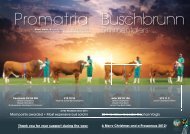Simmentaler Joernaal 2013.indb
Simmentaler Joernaal 2013.indb
Simmentaler Joernaal 2013.indb
Create successful ePaper yourself
Turn your PDF publications into a flip-book with our unique Google optimized e-Paper software.
100<br />
1. Restricted calving periods<br />
As calves are only included in the<br />
same contemporary group if they<br />
are born within 45 or 60 days of one<br />
another, it is essential that small herds<br />
have as shorter calving period as<br />
practical. A calving period of 6 to 8<br />
weeks is ideal.<br />
2. Run all calves under the same<br />
management conditions<br />
Where possible, all calves should be<br />
run under the same management<br />
conditions. If calves are to be split into<br />
different groups it is useful to weigh<br />
the whole group before it is split. For<br />
example, it is possible to take 200 day<br />
weights anywhere between 80 to 300<br />
days of age, so you can weigh all male<br />
calves as a group before a portion of<br />
them are castrated.<br />
3. Weigh all animals on the same day<br />
As BREEDPLAN will only directly<br />
compare the performance of animals<br />
that has been recorded on the same<br />
day, it is important to weigh all animals<br />
within each contemporary group on<br />
the same day.<br />
4. Associated Herds<br />
In the situation where two herds run<br />
their animals together on the same<br />
property, BREEDPLAN can associate<br />
the two memberships to allow the<br />
performance of calves in both herds to<br />
be directly compared together.<br />
5. Use more than one sire<br />
More than one sire should be used<br />
in any joining program. Effective<br />
performance management requires<br />
at least 2 sires to be represented<br />
in each contemporary group if the<br />
performance of the progeny is going<br />
to contribute to the calculation of EBVs<br />
for their sire. Where AI programs are<br />
used they should be timed so that AI<br />
sired calves are born at the same time<br />
as calves sired by natural joining.<br />
6. Supply recipient dam details<br />
Herds that use embryo transfer<br />
need to identify the breed and age<br />
of the recipient dams of ET calves.<br />
If the breed of recipient dams is not<br />
supplied ET calves are split into single<br />
animal analysis groups and therefore<br />
their own performance cannot be<br />
used. To maximise the analysis of ET<br />
calves by BREEDPLAN, it is preferable<br />
if the recipient dams used are all the<br />
same breed.<br />
If you require any further information<br />
about the gathering of effective<br />
performance data or have any queries<br />
regarding the submission of performance<br />
data to BREEDPLAN, please do not<br />
hesitate to contact the office staff.



